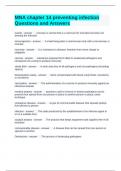Notes de cours
IB Biology Option D: Human Physiology Notes + Detailed Guide
- Cours
- Établissement
THIS IS A DIGITAL PRODUCT SO NO ITEMS WILL BE SHIPPED ───── What is Included? ───── This digital download will give you 40+ pages of very detailed study notes for standard level IB Biology! This detailed guide helped me get a level 7. The topics included are: - Hu...
[Montrer plus]







